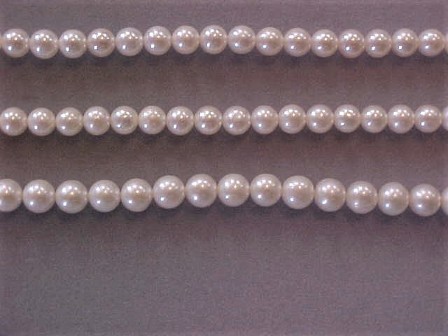Pearl Grading
There are no standardized grading scales for Freshwater Pearls. There are standardized scales for Akoya Pearls and many vendors of Freshwater Pearls have adapted it to Freshwater Pearls.
Below is a picture of the Freshwater Pearls I use on my #1 & #2 Rosaries. I have purchased Freshwater Cultured Pearls from several different vendors, and noticed that one vendor's AA grade was not as good as another vendor's A grade. After studying Pearl Grading on the International Gem Society website site and comparing grading scales on several vendors' sites, I have regraded my Pearls to conform to the grades as illustrated on the picture below. AAA is at the top, then AA+, then AA. Notice the sharpness of the points of light on the top one, and how they are more blurred on the bottom one:

Pearls are graded on roundness (shape), surface smoothness (lack of bumps, scratches, pits or dents) and luster (reflection or shine). The following chart is a consensus from the sites I compared pearl grading on:
AAA Grade Pearls are excellent quality with very high luster, mostly round with a surface that is 95% blemish free.
AA+ Grade Pearls are very good quality with high luster, mostly round to near round with a surface that is 90% blemish free.
AA Grade Pearls are good quality with medium luster, near round with a surface that is 75-80% blemish free
A Grade Pearls are fair quality with low luster, near round to off round with a surface that is 60% blemish free.
The only grade higher than AAA is GEM grade, but those are usually only available as matched pairs for earrings or single Pearls for rings or pendant designs. I have seen one site that grades A to AAAAA but most other pearl vendors scoff at anything beyond AAA and GEM. Some vendors, use an A to D scale of grading for both their Gemstone beads and their Pearls. That makes it somewhat confusing when buying from different vendors. That is why it is necessary to establish a standard that does not yet exist accross the industry. I keep a sample strand in each grade to compare new purchases to.
There are other shapes of Freshwater Pearls - button Pearls like I use on the ends of caps, oval to teardrop drilled longways, and off round potato shape that are side drilled. Some oval, teardrop, off round and potato shape Pearls have rings or grooves around the middle. They are sometimes called Circle' Pearls The Pearls I use on the Sea Treasures and Stella Maris Rosaries are potato shape and usually have grooves around the middle.
What is the difference between Natural Pearls and Cultured Pearls?
Natural Pearls form around a parasite that finds its way into an oyster. The oyster then secretes nacre, the shiny substance that makes a Pearl, to coat the intruder and protect itself from infection. Before 1900, people had to wait a really long time to find enough Pearls to make a necklace. They depended upon running across a Pearl in an oyster without knowing ahead of time if the oyster had a Pearl in it or how long it had been growing. Only the very rich could afford Pearls back then. The only natural Pearls you are likely to find today are in Estate jewelry.
In the early 1900's, Kokichi Mikimoto in Japan used Pinctada Fucata oysters to farm Pearls by placing a round bead cut from shell, covered by tissue from another mollusk inside the oyster, to fool the oyster into thinking a parasite had gotten inside its shell so that the oyster would produce nacre to surround it. Thus the Akoya Pearl was born. Only one Pearl grows in each Pinctada Fucata oyster because it is a small variety. They are usually grown for one year. Japan's waters have become too polluted, so most Akoya Pearls are actually grown in Chinese waters now and some are sent to Japan for processing. Mikimoto developed the A-AAA grading scale for Akoya Pearls, with the GEM quality being called Hanadama. Most Akoya Pearls are 4-8mm.
South Seas and Tahitian Pearls are grown in the South Pacific. They are larger than Akoyas and Freshwater Pearls and are grown in much larger oysters including Golden Lip and Silver Lip Pinctada Maxima and Black Lip Pinctada Margaritifera oysters in deeper waters. Like the smaller Akoyas, they are started out with a bead made of shell. South Seas Pearls are usually White or Gold and grow to 12-16mm in size. They are too large for rosaries. Tahitians are gray to black body color with an array of overtones displayed in green, purple and metallic tones called orient. Some have green body color. They are the same sizes as South Seas Pearls. South Seas and Tahitian Pearls are usually graded on an A-D scale, although some jewelers convert them to an A-AAA scale to minimize confusion.
How are Freshwater Pearls Different?
Freshwater Pearls are grown in rivers and lakes in different types of mollusks, mainly in China. For the most part, they do not contain beads like Akoyas, South Seas and Tahitians. A tiny piece of tissue of one mollusk is placed inside another mollusk and left to grow for several years and because the type of mollusks used in Freshwater Pearl farming don't die when the pearls are removed, they can be checked on, wrapped with another piece of tissue from another mollusk and put back in to grow another year. Several pearls can grow in the same Freshwater Mollusk at the same time. Recently there have been efforts to grow larger Freshwater Pearls in 12-16mm sizes similar to South Seas Pearls and those are often started with round beads cut from shell.
Freshwater Pearl Colors
Pearls have a body color and sometimes a secondary overtone. Freshwater Pearls usually have white, cream, mauve or peach body color. White or Cream body color often has a pink or rose overtone. In addition to the natural colors, Freshwater Pearls can be dyed a variety of colors and are sometimes irradiated to give off a spectacular array of secondary reflections. It is difficult to grade dyed Pearls because the dying process improves them.
Gemstone Grading
There are also no standardized grading scales for Color Gemstones. The GIA (Gemological Institute of America) does have a grading system for diamonds but not for color gemstones such as Amethyst, Emerald, Ruby and other transparent color stones, much less for opaque stones such as Jasper, Tiger Eye or Lapis Lazuli. Many Jewelers use a scale based on saturation of color, brilliance and transparency such as this one for Amethyst found online in image search for gemstone grades with no source given:

Most bead sellers do not use the A to AAA scale. They use the A-D scale with A as the highest grade and the only thing above that is GEM grade which is only used for faceted stones cut for setting in rings, earrings or pendants.
For some transparent stones, such as Amethyst, inclusions of other minerals or other types of the same mineral, such as white or brown quartz, lower the value, although lately some vendors have invented creative names for these lower-quality stones, such as Chevron Amethyst, Flower Amethyst and Dog tooth Amethyst and call it AAA grade! For other stones, such as Rutilated Quartz, inclusions of golden or orange hairlike fibers in interesting patterns makes it more valuable.
Grading Opaque stones is even more subjective. For stones made up of several minerals, such as Lapis Lazuli (Lazurite, Pyrite and Calcite) or Peace Jade (Serpentine, Quartz and Stichtite), the percentage of each mineral and pattern in which it presents itself affects the grading. The best quality Lapis Lazuli is primarily Lazurite in deep violet blue color, with minimal or no Calcite and small quantity, if any, of Pyrite. Some Gemologists prefer small bright golden veins of Pyrite to be present in Lapis Lazuli. Since the best Lapis Lazuli is so hard to get, lighter more mottled Lapis Lazuli,called Denim Lapis in the trade, has become quite popular. It can be very beautiful but is not the same quality or value as the dark blue. In chatoyant stones, such as Tiger Eye, the strength of the color contrast, as well as the movement of light across the stone, affects its grade.
Pricing
The prices of Pearls, Gemstones and Sterling Silver have gone up exponentially over the past few years. There are many reasons for this. Pollution and climate change have affected some areas where Pearls used to be farmed. Japan has too much pollution. Some of the rivers and lakes in southern China have become too warm, so they are farming fish now instead of Pearls.
Gemstones have been affected by wars, politics and the Coronavirus. Iran is the primary source for high-quality Turquoise but the US has not traded with Iran for over 40 years. Arizona and China are scraping the bottoms of their Turquoise mines. Afghanistan has the best quality Lapis Lazuli, but the wars there have made it difficult to get it out of the country. With the Taliban in charge, the future of trade in that country is uncertain.
India and China are the two places where most Gemstone beads end up being cut, drilled and strung. In India most of the work is done by hand and that results in uneven shapes and drill holes that are challenging to get wire through. India has been shut down due to Coronavirus. Many of the Gemstone beads as well as beautiful handmade Sterling Silver beads and caps that are produced in India are not available at this time. China does much more consistent shaping and drilling, but has faced high tariffs lately in trade with the US, so that gets passed on in higher prices for Gemstones and Pearls.
Sterling Silver fluctuates with the Stock Market. The prices may come down a bit once in a while, but the trend is mostly up.
References:
Gemstones of the World by Walter Schumann: Gemstone descriptions and classifications
International Gem Society www.gemsociety.org/reference-library/ Pearl and Gemstone Education articles
Pearls of Joy: www.pearlsofjoy.com/pages/pearl-grading Pearl Education articles
Oriental Pearls: www.orientalpearls.net/pearl-grades/ Pearl Education articles
Fire Mountain Gems: www.firemountaingems.com/resources/gemstones Gemstone Articles
Kitco Historical London Fix www.kitco.com/gold.londonfix.html : Precious Metals Prices
